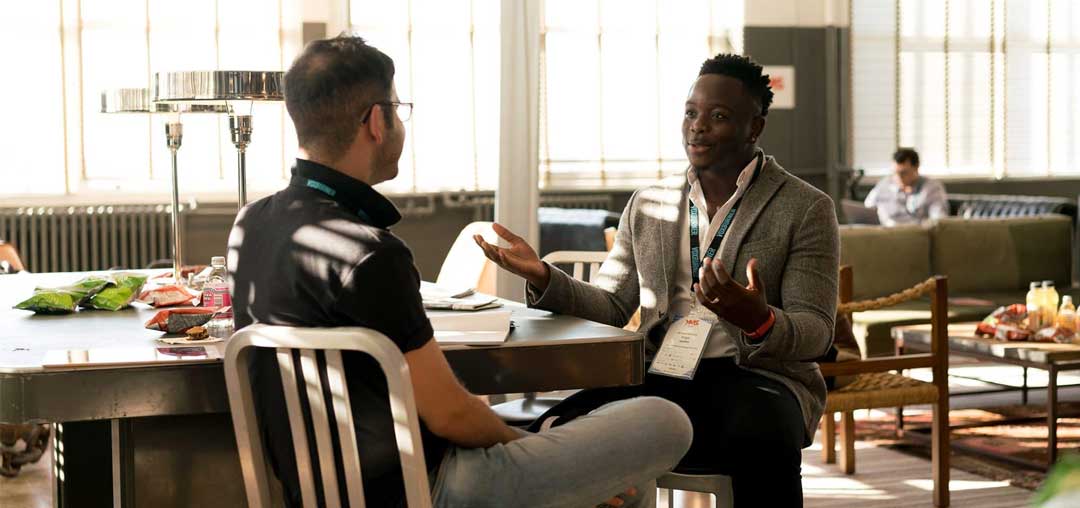When I was a youth pastor, I thought I was pretty funny.
Then I recorded some of my hilarity on video and put it on YouTube.
Not. Awesome.
And no, you can’t find it. It’s gone. However, at the time I believed that since I was having a good time talking to my friends, doing skits, and passing it off as “entertainment,” others would obviously enjoy it too.
Nope. It was only funny to us. Turns out, hosting an interesting and entertaining conversation is a little tougher when those listening don’t know who you are.
Same for podcasting. “Let’s just get together and we’ll talk and record it” doesn’t really work for most people. There’s an art and science to recording a conversational podcast that makes others want to listen to it. Here are a few of the best practices I’ve discovered…
Know your audience
First, you always always always want to know who your audience is. If you are talking about marriage, refrain from youth-oriented words like “fo-rizzle.” Actually, refrain from words like that always. The 90s are back, but not THAT back.
Record in a quiet place
The constant whir of a fan or an audible air conditioner can be distracting. If your kids come in or a dog starts barking nearby (looking at you, neighbors) then listeners may start trying to figure out what’s going on in the background instead of listening to you.
Invest in good equipment
Don’t be afraid to spend a little money. You can find a good digital interface and a mic both for under $100 and sound pretty good. If you sound like you’re recording in a trash can, that’s where people will put your podcast. You know, metaphorically. The trash can in their mind. Their trash-mind.
Plan your episode ahead of time
I always plan a set of questions I want to ask my guest and send them over beforehand. Why? Because it’s my show and how it goes is more important to me than to my guest. I want to make sure my audience hears valuable information, not 15 minutes about what I had for lunch (it was a burger).
Treat listeners like their time is valuable by planning your show and how you want it to go. I used to do the same thing when I was a youth pastor planning my talk every Wednesday night.
Stay loose with the notes and keep it conversational, but keep them in front of you so you can stay on point. It also keeps you from talking at the same time as the others on the show. I HATE having to decipher shows like that. I also HATE The View. Same category. Trash-minded.
Get to know your guest
Don’t just jump right into recording, especially if you don’t know your guest very well. How many first conversations ever do you really want recorded and published? Spend a few minutes getting comfortable with each other, even if you already know one another.
The first time I interviewed my good friend, Adam McLaughlin, we had just met briefly and I definitely stunned him with a really hard question at the end of the podcast that I had to cut out. He had no idea who I was or how to take my sense of humor, so the question just shook him, instead of making him laugh. No, I won’t be telling you what I asked here. Maybe over in my Facebook group if someone asks…
Watch the clock
When I record, I have Garageband open and I have it set to the timer at the top. That way I can watch to see how long the episode goes. I want to shoot for about 30 min or less, so I know I have about 20-25 minutes to talk to my guest before I will have to start editing away a lot of good stuff or deciding to leave the episode super long.
A good guage is 20-30 minutes. Really, keeping it around 20 minutes is ideal because that is the average commute time to and from work.
Let your guest talk
As fascinating as I think I am, I asked the guest on to bring their expertise. I always try to ask questions that will give them something to go on for a few minutes. If I feel I have something valuable to add, I will, but I try not to simply agree with them for an additional 2-4 minutes afterward just to hear myself talk. I’ve had guests on before though that wouldn’t let me get a word in. That’s ok. We just take care of that in the editing phase. Perfect segueeeeeeeee……
Edit to the story, not the quantity
If you have 10 minutes of gold vs. 20 minutes of “meh,” edit to the 10 minutes of gold. Find the important story or points and make them shine. You don’t have to edit out the “ums” every single time unless it’s unbearable, but you will need to take out the rabbit trails and such that don’t really stay on target or contribute to your goal with the episode.
I don’t do this very well, in my opinion. My shows tend to be really long because I can talk to a wall about communications for hours. I will, however, immediately shut down on the topics of sportsball, finances, or reality television. It’s really hard to whittle down to the most important things in your episode.
What did I miss? I’m sure those of you who have done conversational podcasts before can give a few more tips and tricks, so sound off in the comments!
I’m speaking at an exciting conference soon called The Engage Conference put on by Text in Church. It’s February 4-12 and it’s all online! OH, and it’s FREEEEEEEE!
You can sign up for it HERE and get access to an incredible lineup of speakers that can help you grasp church communication in 2019 like never before!

